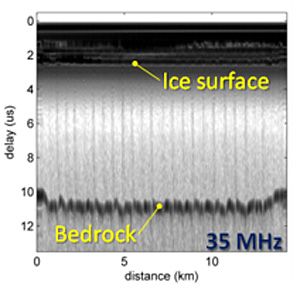From IEEE Spectrum:
A group of researchers from the Center for the Remote Sensing of Ice Sheets at the University of Kansas is right now at the sub-glacial Lake Whillans field camp on the Whillans Ice Stream in Antarctica. The team is testing a system they’ve devised that includes a 100-watt ice-penetrating radar carried aboard a small unmanned aerial vehicle.
Probing glacial ice with radar is nothing new. That’s long been done both by towing radar equipment across the ice and by flying it over the ice on airplanes. Synthetic-aperture approaches have even been used. But this is the first time anyone has obtained radar soundings of ice using a small drone.
The aircraft these researchers chose is one of their own design and has a rather peculiar appearance—at least for such an application. You might ask: Why does this pilotless UAV have a cockpit? That's because it was derived from earlier work the group did using an ordinary radio-control model that could be bought off the shelf: a 1/3-scale Yak 54. (The Yak 54, popular in modeling circles, is based on a 1990s-era aerobatic aircraft produced by the Moscow-based Yakolev Aircraft Corporation.)
The radar soundings were done using a somewhat larger airframe, but one that still very much resembles a “Yak,” as it is known to RC modelers. The plane, which these researchers refer to as the GX1, weighs 37 kilograms in all, including 2 kilograms of radar gear, which can be operated on two bands: 14 and 35 MHz.
The plane takes off and lands under the control of what some UAV operators refer to as an “external pilot,” meaning someone who is on the ground looking up at the plane rather than flying it while looking at a video feed being transmitted from the air. Once it’s airborne, though, the pilot can put the plane into a largely autonomous mode in which the plane’s autopilot takes over and flies to whatever waypoints are commanded. The little aircraft has a range of more than 200 kilometers, running on just a few liters of fuel.
The University of Kansas researchers plan to miniaturize their radar gear still further and build a small fleet of drone aircraft that can probe the depths of fast-flowing glaciers with closely spaced radar measurements taken from the air.

Comments
You mean , If few 100 of them are in demand then China will make it any way :)
If it's a useful tech China will start making it Joe ;-)
Brilliant!
I am more interested in the Radar though...The A/C wingspan is presumably not more than 3meters or so, so what sort of antenna are used at 14MHz to do the Radar work?
Interesting project. I am looking at a similar application but to measure tree canopy density, using much higher Radar Frequencies, but it seems all the small ( sub 10watt PEP, sub 1kg) SHF radars are ITAR contolled by the good Old USA...
Joe
The Nampilot